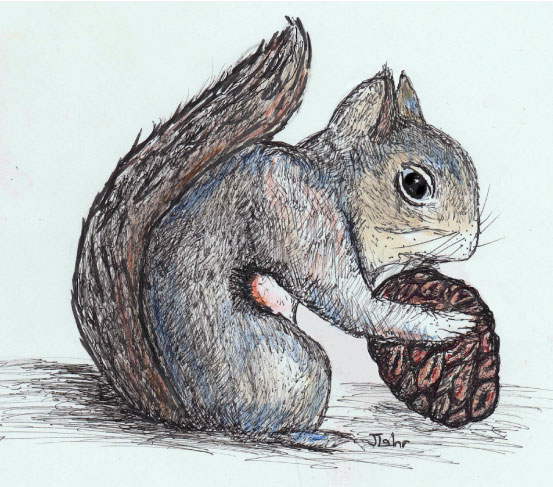Imagine for a moment if we had opportunity to spend the day with John Muir as our mountain guide. As Muir leads us into the upper montane forest, he excitedly speaks of searching out the "wildest animal I ever saw." Would you be delighted or disappointed to discover that this creature is less than a foot in length and weighs just a few ounces? This animal is the Douglas squirrel or chickaree (Tamiasciurus douglasii). If you shared Muir's sensibilities you would be delighted to share your wilderness adventure with this diminutive creature that he referred to as "a fiery, sputtering little bolt of life." This squirrel so captivated Muir that he devoted a chapter of his book, The Mountains of California, to colorfully describing its habits and antics. Since Muir is unavailable to join us on an adventure, we can best share his thoughts by referring to the chapter devoted to the Douglas squirrel in this classic book on the natural history of Yosemite and other wild California mountains (1894).

The Douglas squirrel, sometimes referred to as the chickaree, makes its home in coniferous forests of the northwest from British Columbia south to the Sierra Nevada. In Yosemite a favorite place to spy this energetic squirrel is among the big trees of giant sequoia groves where they play a special role in the regeneration of the big trees.
The Douglas squirrel can be found on the ground, bouncing from log to log, but seems to be most comfortable in the boughs of the trees. One of the acrobats of the forest, the Douglas squirrel is built for life among the limbs of conifers. Strong needle-like claws allow it to cling and scamper among the upper boughs of a tree. With a bushy tail aiding in balance, the squirrel does not hesitate to jump several body lengths from one tree to another. "He is the squirrel of squirrels flashing from branch to branch... the Douglas leaps and glides in hidden strength seemingly as independent of common muscle as a mountain stream." (Muir:229)
The Douglas squirrel has a large repertoire of vocalizations that it will share with visitors: chirping, clicking, barking, and even a trill. Muir called it the mockingbird of squirrels. Territorial violators such as other squirrels or chipmunks will have to contend with a barking reprimand that Muir describes: "Woe to the squirrel or chipmunk that ventures to set foot in his favorite tree, they are kicked downstairs with comic vehemence while a torrent of angry notes comes rushing from his whiskered lips that sounds remarkably like swearing." (Muir:230)
The Douglas squirrel does not hibernate. To prepare for a bleak winter, the chickaree will cut and cache loads of cones. Some research indicates that they will cut and store several hundred sequoia cones per hour as they prepare for the winter. This is an important aspect of the regeneration of the mighty sequoia. The giant sequoia is unable to release its own seeds from the cone, which will stay green and growing in the top of the tree for twenty years or more. The Douglas squirrel is one agent for seed release. When gathering cones for the winter, the Douglas squirrel severs the stem of the cone from the tree, and the cone can now die and dry, releasing the 200 or so seeds secured within it. During winter, the squirrel will consume the fleshy sections of the cone and scatter the seeds. Some of these seeds will sprout and become the next season's crop of young sequoia trees.
Perhaps for these reasons, John Muir concluded: "The Douglas squirrel is by far the most interesting and influential of the California Sciuridae [squirrel family], surpassing every other species in force of character, numbers, and extent of range, and in the amount of influence he brings to bear upon the health and distribution of the vast forests he inhabits." - The Mountains of California by John Muir, 1894.
